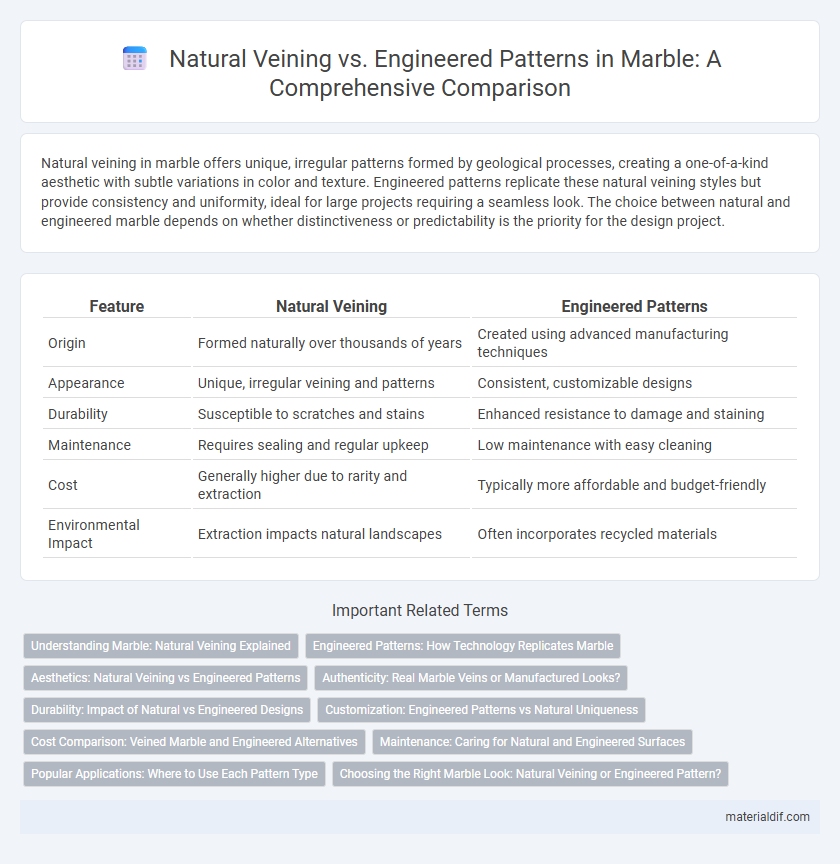Natural veining in marble offers unique, irregular patterns formed by geological processes, creating a one-of-a-kind aesthetic with subtle variations in color and texture. Engineered patterns replicate these natural veining styles but provide consistency and uniformity, ideal for large projects requiring a seamless look. The choice between natural and engineered marble depends on whether distinctiveness or predictability is the priority for the design project.
Table of Comparison
| Feature | Natural Veining | Engineered Patterns |
|---|---|---|
| Origin | Formed naturally over thousands of years | Created using advanced manufacturing techniques |
| Appearance | Unique, irregular veining and patterns | Consistent, customizable designs |
| Durability | Susceptible to scratches and stains | Enhanced resistance to damage and staining |
| Maintenance | Requires sealing and regular upkeep | Low maintenance with easy cleaning |
| Cost | Generally higher due to rarity and extraction | Typically more affordable and budget-friendly |
| Environmental Impact | Extraction impacts natural landscapes | Often incorporates recycled materials |
Understanding Marble: Natural Veining Explained
Natural marble veining is formed through mineral impurities and geological processes, creating unique, irregular patterns that cannot be exactly replicated. Engineered marble patterns are manufactured, offering consistent design and color control but often lack the depth and organic variation found in natural stone. Understanding these differences helps in choosing marble that meets both aesthetic desires and functional needs.
Engineered Patterns: How Technology Replicates Marble
Engineered patterns use advanced digital imaging and 3D printing technology to replicate the intricate veining and color variations found in natural marble, ensuring consistent design quality and customization. These patterns allow for precise control over aesthetics, durability, and installation flexibility, making them a popular choice in modern architecture and interior design. Technology-driven manufacturing processes enable engineered marble surfaces to mimic natural stone while offering enhanced resistance to stains and scratching.
Aesthetics: Natural Veining vs Engineered Patterns
Natural veining in marble offers unique, organic patterns formed over millennia, enhancing each slab's distinctiveness and luxury appeal. Engineered patterns provide consistent, customizable designs that mimic natural aesthetics while allowing greater control over color and intensity. The choice between natural veining and engineered patterns significantly impacts the visual texture and character of marble installations in architectural and interior design.
Authenticity: Real Marble Veins or Manufactured Looks?
Natural marble features authentic veining formed over millions of years, creating unique, irregular patterns that cannot be exactly replicated. Engineered marble replicates these veins using man-made techniques, offering consistent and customizable designs but lacking the depth and organic variation of genuine stone. Choosing real marble ensures a truly one-of-a-kind aesthetic prized for its natural authenticity and timeless elegance.
Durability: Impact of Natural vs Engineered Designs
Natural veining in marble originates from unique mineral deposits formed over millions of years, contributing to its distinctive patterns but making it more prone to fractures and surface wear under heavy impact. Engineered marble, enhanced with resins and polymers, offers superior durability by resisting chipping and cracking, making it ideal for high-traffic areas and demanding environments. The impact resistance of engineered designs generally surpasses that of natural veining, providing a longer lifespan and reduced maintenance costs.
Customization: Engineered Patterns vs Natural Uniqueness
Engineered marble patterns offer extensive customization options, allowing precise control over color, veining, and design to match specific aesthetic preferences and architectural requirements. Natural veining in marble is inherently unique, formed through geological processes over millions of years, resulting in one-of-a-kind patterns that cannot be exactly replicated. While engineered patterns provide consistency and repeatability for large projects, natural veining enhances the exclusivity and organic beauty of each marble slab.
Cost Comparison: Veined Marble and Engineered Alternatives
Natural veining in marble showcases unique, organic patterns that often demand higher prices due to quarrying, rarity, and labor-intensive extraction processes. Engineered marble patterns offer consistent design options at a lower cost, benefiting from synthetic production and reduced material waste. While natural veined marble commands premium investment for its exclusivity, engineered alternatives provide budget-friendly versatility without sacrificing aesthetic appeal.
Maintenance: Caring for Natural and Engineered Surfaces
Natural marble veining requires regular sealing to prevent stains and preserve its unique patterns, while engineered marble surfaces offer increased durability and resistance to scratches, reducing maintenance frequency. Both types benefit from gentle cleaning agents and immediate spill cleanup to maintain their aesthetic appeal. Proper care extends the lifespan of natural and engineered marble, ensuring long-lasting beauty and performance.
Popular Applications: Where to Use Each Pattern Type
Natural veining in marble is preferred for luxury applications such as countertops, flooring, and statement walls due to its unique, irregular patterns that enhance elegance and authenticity. Engineered marble patterns are widely used in commercial spaces, bathrooms, and modern kitchens where consistent color and design uniformity are essential for sleek, contemporary aesthetics. Choosing between natural veining and engineered patterns depends on project requirements for durability, visual impact, and maintenance considerations in each setting.
Choosing the Right Marble Look: Natural Veining or Engineered Pattern?
Natural veining in marble offers unique, organic patterns formed by mineral deposits over centuries, providing authentic aesthetic appeal and one-of-a-kind designs. Engineered patterns in marble use advanced manufacturing techniques to replicate these natural veining effects while allowing for consistent color, pattern control, and enhanced durability. Selecting the right marble look depends on prioritizing either the distinctiveness and natural variation of veining or the uniformity and customization offered by engineered marble surfaces.
Natural veining vs Engineered patterns Infographic

 materialdif.com
materialdif.com